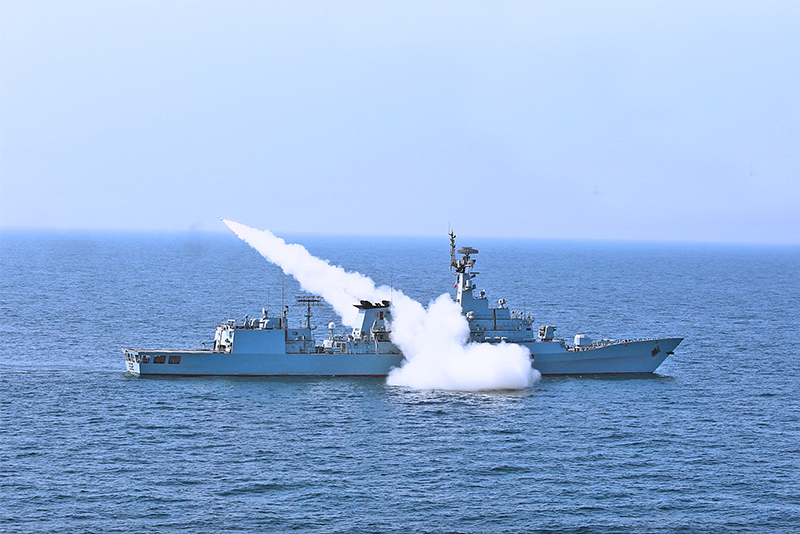Pakistan Navy is among the three branches of Pakistan’s armed forces. It is among the significant actors that contribute to protecting Pakistan’s interests. Even with limited resources, it has proven to protect the state from threats with its capabilities in the past. The strategic vision of the Pakistan Navy is to protect the maritime interest of the state and to contribute to the national security of the state by protecting the state from any aggression by hostile forces. In addition to protecting the maritime interests of the state, it also protects the economic interests of the country after the initiation of the China-Pakistan Economic Corridor (CPEC). The responsibility of the Pakistan Navy extends far beyond protecting the coastline to keeping the sea lanes of communication secure in the country,as 96% of trade occurs through sea routes. To protect the country’s economic interest and to protect the country from the threat posed by the Indian Naval Doctrine, which is focused on the modernization of Indian Navy capabilities and becoming a regional hegemon in the Indian Ocean region, the Pakistan Navy has taken significant measures to modernize its naval capabilities.
Pakistan is actively engaging with states like China and Turkey to modernize its naval capabilities and build up its naval forces. Pakistan Navy has signed a contract with China Shipbuilding Trading Company Ltd to acquire 4 Type 054 A/P Frigate, which is state-of-the-art technology. The names of 4 Type 054 A/P Frigate are PNS Turgil, PNS Taimur (262), PNS Tippu Sultan (FF-263) and PNS Shah Jahan (FFG-264). These ships were commissioned at Hudong Zhonghua (HZ) Shipyard, China. These ships are technologically advanced and highly capable, with
enormous surface-to-surface, surface-to-air, and underwater firepower besides extensive surveillance potentials. Pakistan Navy has also acquired P282/CM-401 anti-ship weapons of a supersonic nature. These weapons have the capability of anti-ship and land-attack strikes. These weapons are neutralizing the threat posed by Indian Dhanush ship-launched ballistic missiles.
During Chinese President Xi Jinping’s visit to Pakistan, A contract was signed between Pakistan and China Shipbuilding & Offshore International Company Ltd (CSOC), under which Pakistan will buy eight Hangor class submarines. The first four will be built in China, and the remaining ones will be constructed at Pakistan’s Karachi Shipyard & Engineering Works Ltd under the transfer of technology. These submarines will be equipped with Babur-3 submarine-launched cruise missiles, which would have a range of 450 kilometers. The vessel will also be equipped with an air-independent propulsion system that will significantly increase its underwater endurance, and it will be difficult for enemies to trace it.
The Pakistani National Defense Ministry Ammunition Production and Karachi Shipyard and the Military Factory and Shipyard Management Corporation (ASFAT) of Turkey signed a contract in 2018 under which the Pakistan Navy will acquire four Milgem class corvettes which would be constructed based on Turkish Ada-class design. These corvettes have a range of 3500 kilometers; this was another significant step for the Pakistan Navy to modernize its capabilities and increase its fleet. These corvettes will be able to conduct a wide range of missions, including reconnaissance, and anti-submarine warfare, and will significantly enhance the Pakistan Navy’s operational capabilities. Pakistan Navy is also working on projects for the most modern warships, known as Jinnah class frigates, with the Turkish Navy. It will first indigenously design and build a frigate. It will accommodate 200 personnel and will have a range of 4000 nautical miles. It will be equipped with a Combined diesel and diesel (CODAD) propulsion system.
Another area in which the Pakistan Navy works is the air defense system. They are currently operating advanced UAVs (unmanned Ariel vehicles) such as Scan Eagle. This UAV can attain an altitude of about 15,000 feet and has a maximum endurance of more than 12 hours. It is equipped with state-of-the-art sensors, such as a maritime automatic identification system and a video detection and ranging camera. Moreover, it needs a runway to operate. LUNA NG is another UAV that the Pakistan Navy is operating. It helps with real-time airborne surveillance, detection, and tracking. It has a flight time of over 12 hours with a spatial coverage of 30,000 square kilometers. These UAVs enhance the capability of the Pakistan Navy to perform aerial surveillance in its area of responsibility.
Pakistan Navy has made significant technological advancements in the new submarines, frigates, air defense systems, and maritime patrol aircraft to modernize its naval capabilities. These technological advancements, such as UAVs in the air defense systems, have increased the operational and surveillance capability of the Pakistan Navy compared to that of its regional naval forces, such as India. P282/CM-401 supersonic anti-ship weapons acquired by the Pakistan Navy can counter the Indian naval BrahMos very effectively. Pakistan navy, due to its latest acquired technologies, which were used in underwater surveillance, was able to detect the Nuclear Submarine of the Indian Navy and prevent it from entering Pakistani waters. Thus, technological advancements in naval capabilities have significantly enhanced the operational capabilities of the Pakistan Navy compared to its regional naval forces.

Table of Contents
ToggleM. Hammad Madni
M. Hammad Madni is a student of International Relations at Air University, Islamabad. He has published opinion articles on global affairs with the Institute of Strategic Studies Islamabad (ISSI). His areas of interest include South Asian politics, international law, and emerging technologies.













